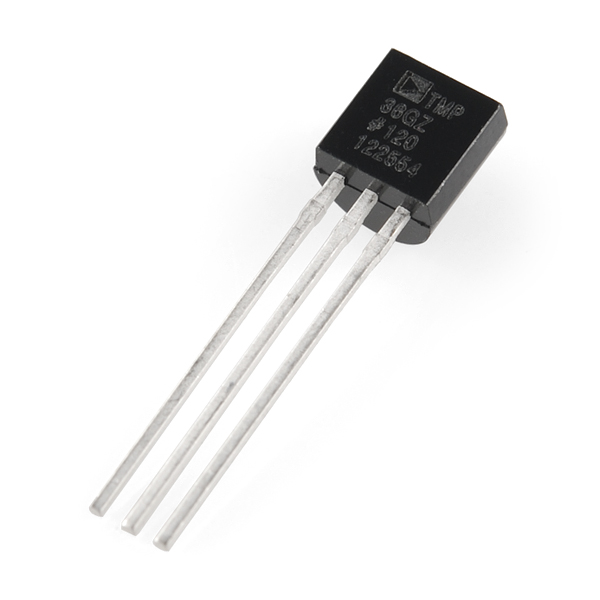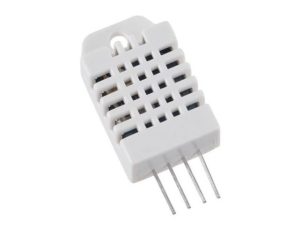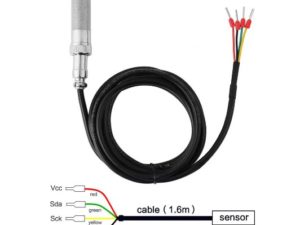Description
 The TMP36 is a low voltage, precision centigrade temperature sensors. It provide a voltage output that is linearly proportional to the Celsius (Centigrade) temperature. The TMP36 do not require any external calibration to provide typical accuracies of ±1°C at +25°C and ±2°C over the –40°C to +125°C temperature range.
The TMP36 is a low voltage, precision centigrade temperature sensors. It provide a voltage output that is linearly proportional to the Celsius (Centigrade) temperature. The TMP36 do not require any external calibration to provide typical accuracies of ±1°C at +25°C and ±2°C over the –40°C to +125°C temperature range.
Applications
- Environmental Control Systems
- Thermal Protection
- Industrial Process Control
- Fire Alarms
- Power System Monitors
- CPU Thermal Management
Getting started with the TMP36 Low Voltage Temperature sensor
In this tutorial you will learn how to use the TMP36 sensor with Arduino uno. The room temperature will be printed to serial monitor.
Hardware required
- Arduino Uno
- Breadboard
- Jumper wires
- TMP36
Connecting the Hardware
Since this sensor is very simple and does not require any supporting components we will be directly connecting the sensor to the Arduino. Start by bending the legs on the TMP36 sensor so they will fit into the breadboard. connect a jumper wire from the Arduino’s 5VDC pin and running it to the sensor’s “pin 1”. Next, run another jumper wire from one of the Arduino’s ground pins to the sensor’s “pin 3” .We are going to be using one of the Arduino’s analog input pins for this tutorial. Run a jumper wire from the sensor’s “pin 2” (the middle pin) to an analog input. We will be using analog input 0 in this tutorial.

The code
const int temperaturePin = 0;
void setup()
{
// In this sketch, we’ll use the Arduino’s serial port
// to send text back to the main computer. For both sides to
// communicate properly, they need to be set to the same speed.
// We use the Serial.begin() function to initialize the port
// and set the communications speed.
// The speed is measured in bits per second, also known as
// “baud rate”. 9600 is a very commonly used baud rate,
// and will transfer about 10 characters per second.
Serial.begin(9600);
}
void loop()
{
// Up to now we’ve only used integer (“int”) values in our
// sketches. Integers are always whole numbers (0, 1, 23, etc.).
// In this sketch, we’ll use floating-point values (“float”).
// Floats can be fractional numbers such as 1.42, 2523.43121, etc.
// We’ll declare three floating-point variables
// (We can declare multiple variables of the same type on one line:)
float voltage, degreesC, degreesF;
// First we’ll measure the voltage at the analog pin. Normally
// we’d use analogRead(), which returns a number from 0 to 1023.
// Here we’ve written a function (further down) called
// getVoltage() that returns the true voltage (0 to 5 Volts)
// present on an analog input pin.
voltage = getVoltage(temperaturePin);
// Now we’ll convert the voltage to degrees Celsius.
// This formula comes from the temperature sensor datasheet:
degreesC = (voltage – 0.5) * 100.0;
// While we’re at it, let’s convert degrees Celsius to Fahrenheit.
// This is the classic C to F conversion formula:
degreesF = degreesC * (9.0/5.0) + 32.0;
// Now we’ll use the serial port to print these values
// to the serial monitor!
// To open the serial monitor window, upload your code,
// then click the “magnifying glass” button at the right edge
// of the Arduino IDE toolbar. The serial monitor window
// will open.
// (NOTE: remember we said that the communication speed
// must be the same on both sides. Ensure that the baud rate
// control at the bottom of the window is set to 9600. If it
// isn’t, change it to 9600.)
// Also note that every time you upload a new sketch to the
// Arduino, the serial monitor window will close. It does this
// because the serial port is also used to upload code!
// When the upload is complete, you can re-open the serial
// monitor window.
// To send data from the Arduino to the serial monitor window,
// we use the Serial.print() function. You can print variables
// or text (within quotes).
Serial.print(“voltage: “);
Serial.print(voltage);
Serial.print(” deg C: “);
Serial.print(degreesC);
Serial.print(” deg F: “);
Serial.println(degreesF);
// These statements will print lines of data like this:
// “voltage: 0.73 deg C: 22.75 deg F: 72.96”
// Note that all of the above statements are “print”, except
// for the last one, which is “println”. “Print” will output
// text to the SAME LINE, similar to building a sentence
// out of words. “Println” will insert a “carriage return”
// character at the end of whatever it prints, moving down
// to the NEXT line.
delay(1000); // repeat once per second (change as you wish!)
}
float getVoltage(int pin)
{
// This function has one input parameter, the analog pin number
// to read. You might notice that this function does not have
// “void” in front of it; this is because it returns a floating-
// point value, which is the true voltage on that pin (0 to 5V).
// You can write your own functions that take in parameters
// and return values. Here’s how:
// To take in parameters, put their type and name in the
// parenthesis after the function name (see above). You can
// have multiple parameters, separated with commas.
// To return a value, put the type BEFORE the function name
// (see “float”, above), and use a return() statement in your code
// to actually return the value (see below).
// If you don’t need to get any parameters, you can just put
// “()” after the function name.
// If you don’t need to return a value, just write “void” before
// the function name.
// Here’s the return statement for this function. We’re doing
// all the math we need to do within this statement:
return (analogRead(pin) * 0.004882814);
// This equation converts the 0 to 1023 value that analogRead()
// returns, into a 0.0 to 5.0 value that is the true voltage
// being read at that pin.
}
// Other things to try with this code:
// Turn on an LED if the temperature is above or below a value.
// Read that threshold value from a potentiometer – now you’ve
// created a thermostat!
NOTE: IF you get stray ‘223’ errors ,stray ‘226’ in program The problem is with your ” = ( ) and ” – * characters. Replace them with ordinary quotes ” = ” () – * and you should be fine.
Upload The Code And Test
Now that all of the code has been written it can be uploaded to your Arduino! Click “Upload” button in the top left corner of the Arduino IDE and it should upload without any issues. Next, click the “Serial Monitor” button in the top right corner (it looks like a magnifying glass). After a few seconds you should start to see a stream of data appear in the window – that is your temperature in degrees Celsius.








Reviews
There are no reviews yet.